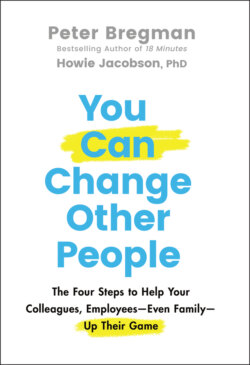Читать книгу You Can Change Other People - Howie Jacobson, Joel McDonald - Страница 18
CHAPTER 6 POWER 4: FUTURE-PROOFING: CHANGE IS A FUTURE THING
ОглавлениеLet's do a quick recap: People change when they take ownership, develop independent capability, and exercise emotional courage in the face of fears and setbacks. Our success changing others requires developing these traits in the people we're helping.
But we don't just want people to change for this moment. We want them to transform their sticky problems and unfulfilled desires into an opportunity to get better, stronger, and more resilient in the future. To bounce back from that next challenge and grow to meet future opportunities. That's future-proofing.
One of the downsides of giving advice or solving someone else's problem is that they lose out on the future benefits of their current struggle.
By telling Octavia what the spreadsheet should look like, or (worse) creating it for her, Spencer deprived her of the chance to figure it out and become a better marketer and a more skilled leader.
Life doesn't stand still. Getting better at solving today's problems doesn't prevent tomorrow's. Just the opposite, in fact: developing yourself means setting yourself up for bigger, more challenging problems in the future.
The next time there's a slightly different problem, Octavia will be equally dependent on Spencer to solve it for her. For her change to be sustainable, she needs to become future-proof.
You can help people develop resilience, as well as their ability to grow themselves, their leadership, and their organizations, by guiding and supporting them to intentionally and proactively use their difficulties to grow stronger.
At first, Daniel just wanted a gaming computer. He would have been fine—over the moon, actually—with just getting it delivered from Amazon. But that wasn't an option. So Daniel took advantage of the problem—I wasn't going to buy it for him, and he didn't have the money to buy it—to put himself in a much better position than just having a new computer.
After all, computers break. Suppose I had capitulated and bought him his dream machine. One day he kicks over the CPU during a particularly rousing game of Rocket Launcher and damages the motherboard. Now he's back where he was before, except much sadder.
Given how he's changed in the process of building his computer, that wouldn't be nearly as big a deal now. He knows how to find a motherboard online for under $150, and he's got the gear, know-how, and experience to earn that sum through a few hours of drone videography for nearby realtors.
In fact, given his new business, he can probably upgrade every part of his computer every few months—or even start another business building and selling gaming computers, or monetize a YouTube channel of his tutorials and reviews. In fact, now that he's tasted entrepreneurship, the sky's the limit.
In short, he dealt with a problem not just by solving it, but by solving it in a way that puts him in a much stronger, more capable position than if the problem had never presented itself.
***
We've identified how people change—through ownership, capability, emotional courage, and future-proofing. Now it's time to go from theory and concept into practice. Keep these “change powers” in mind as you dive into the Four Steps. You'll notice that each of the steps actualizes at least one—and often more—of these powers.
In the following group of chapters, we'll dive into Step 1 with a powerful mindset change to get you and the person you want to change on the same side, acting like partners. When you emerge from this step, the person you want to change will see you as an ally, not a critic, and you will be perfectly positioned to help them move forward in their change.
